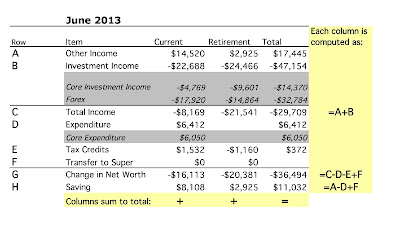This year was much like 2012 career- and personal life-wise. Financially, the main difference is that the Australian Dollar fell from $US 1.0392 to $US 0.8928. This means that though it was another strong year for underlying investment returns, net worth in USD grew much more slowly than last year and in AUD terms much faster. In AUD we went from $759k to $1.097 million. In USD terms from $789k to $980k.
These are the annual accounts that sum each of my monthly reports for the year in Australian Dollars:
Non-investment income was up partly because of pay rises but also because I got some extra pay for taking on additional responsibilities at work. My pay will actually fall in 2014 as that has now ended. Also, there was quite a bit of work related expenditure refunds (see below). Investment income was twice as much this year as last partly because the portfolio was growing and investment returns were 25.6% this year vs. 16.9% last. It is hard to imagine that they will be this good again in 2014. As a result comprehensive income came in at $444k. Remember that this is an after tax result (mostly - investment earnings are computed pre-tax), also that $162k is locked up in retirement accounts.
Spending was at a record level of $88k. About $11k of this was work related etc. spending that was refunded. We did a lot of travel and recently started private health insurance. I estimate that if we were maximally frugal we could have spent just $49k, which is the item marked "needs" above.
As a result, net worth rose $339k. Saving from regular income was $109k.









































